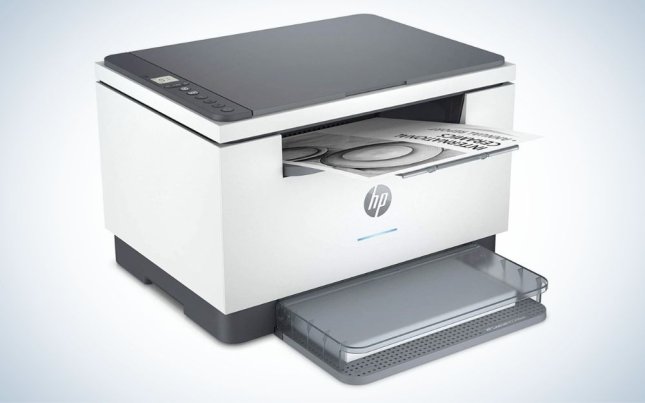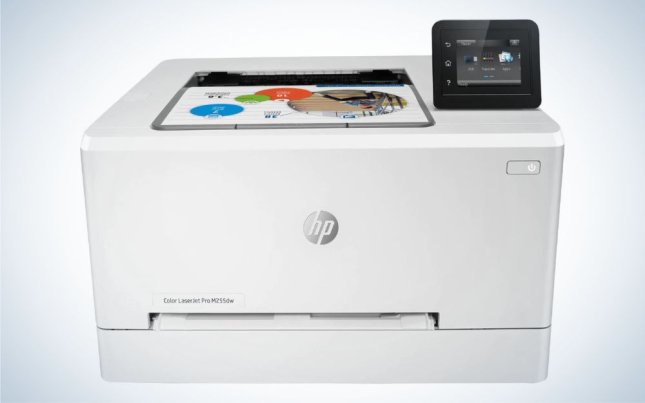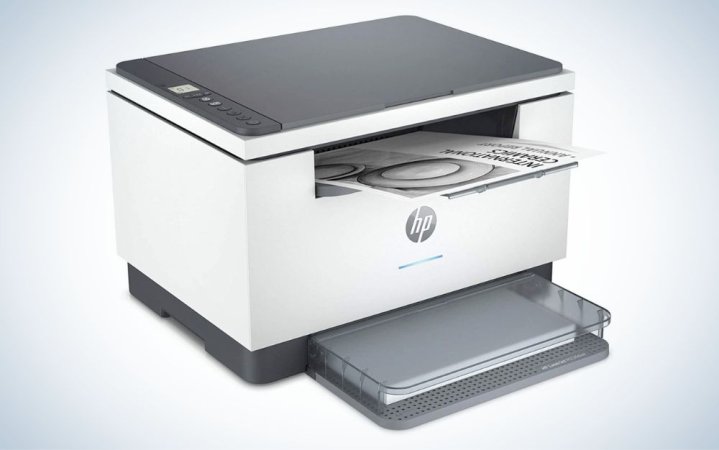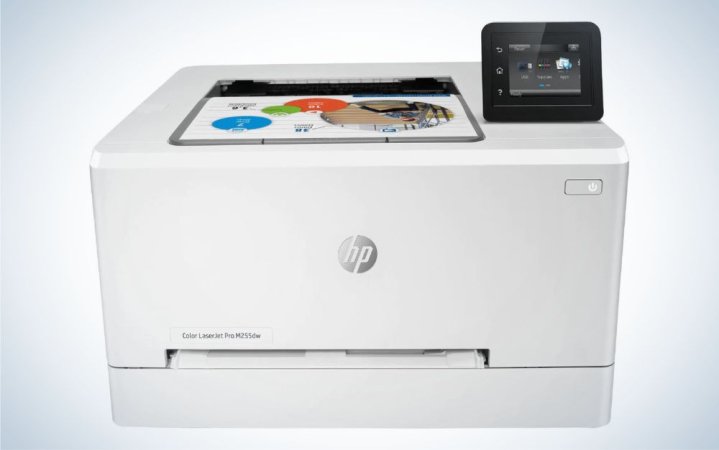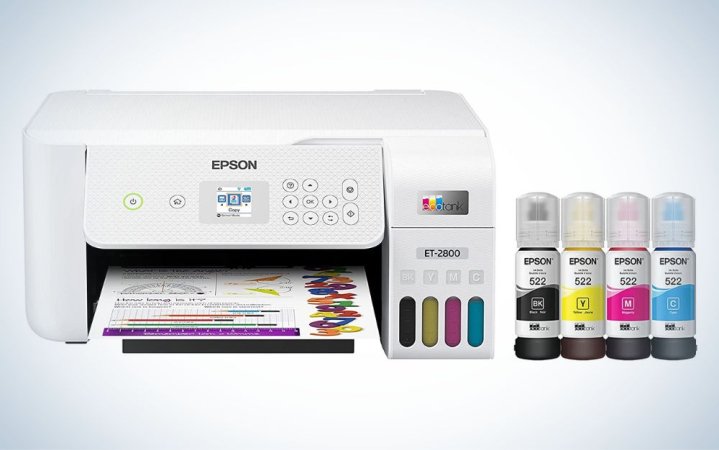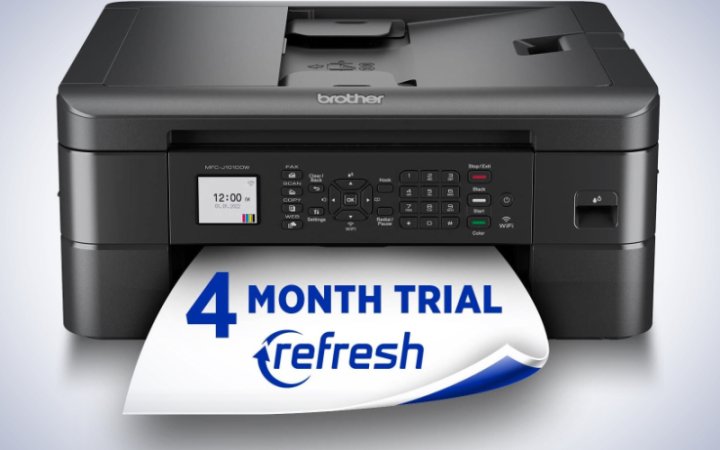We may earn revenue from the products available on this page and participate in affiliate programs. Learn more ›

Head out into the market, and you won’t find any dedicated Chromebook printers. Generally, manufacturers try to offer models that work with just about any computer and even smartphone in hopes of reaching the largest audience. Google recently did away with its Cloud Print feature on which ChromeOS previously relied. That has changed the way Chromebooks print, arguably for the better. Of course, you’ll want to pay attention to some key features and capabilities whether you’re using the printer with a Chromebook or another computer or mobile device. A vast array of features and granularly different models can make choosing the best device tricky, so we have curated this list of the best printers for Chromebooks to make it as easy as possible for you.
- Best overall: HP LaserJet MFP M234dwe
- Best color laser: HP LaserJet Pro M255dw
- Best inkjet: Epson EcoTank ET-2800
- Best photo printer: Canon Pixma TR8620a
- Best portable printer: Canon Pixma TR150
- Best budget: Brother MFC-J1010DW
How we chose the best printers for Chromebooks
As a longtime freelance writer who has covered technology for publications like Reviewed, Popular Mechanics, Engadget, and, of course, Popular Science, I’ve spent a lot of time using printers and staying up-to-date on the latest offerings. To pick the printers for this guide, I relied on my own experience with different printer manufacturers. Also, I turned to reviews from trusted sources, as well as customer reviews, to help determine the best options for Chromebooks that are currently available.
The best printers for Chromebooks: Reviews & Recommendations
Printers range from inexpensive consumer models to pricey professional-grade machines. The printers we selected for this guide all fall somewhere in the middle, avoiding the cheap, frustrating models and also leaving the highest-end options for another guide since they would likely be overkill for most average Chromebook users.
Best overall: HP LaserJet MFP M234dwe
Best overall
All-inclusive
Why it made the cut: The vast majority of printing jobs only require black-and-white text, and this printer excels in that arena.
Specs
- Printer type: Laser
- Pages per minute: 30
- Features: Scanner, two-sided printing, Bluetooth, WiFi, Ethernet
- Size: 14.49” W x 11.76” D x 9.52” H
Pros
- Affordable upfront and toner costs
- Compact for an all-in-one laser printer
- Six months of toner included with purchase
Cons
- HP+ system requires HP account and an internet connection
For most people, a black-and-white all-in-one laser printer is the most sensible option, and HP’s LaserJet MFP M234dwe hits all the right marks for everyday home or office use. The printer itself is fairly inexpensive, and HP’s Instant Ink subscription program makes the running costs of using the printer affordable over the long run. You can also choose to just purchase toner as needed if you aren’t doing a ton of printing. It outdoes many similarly priced laser printers with a fast 30 pages-per-minute print speed (or 19 pages double-sided). Unfortunately, as is increasingly becoming the norm these days, you will need to sign up for an HP account to actually set up the printer, and maintain an internet connection to continue to operate it. That won’t be a problem for most folks, but it could be a deal-breaker in some instances, so make sure you know what’s required before making a purchase.
Best laser: HP LaserJet Pro M255dw
Best laser
Color upgrade
Why it made the cut: Color printing quickly bumps up the cost of a laser printer, but the HP LaserJet Pro M255dw is still fairly affordable and produces great results.
Specs
- Printer type: Laser
- Pages per minute: 22 (color/black and white)
- Features: Two-sided printing, touchscreen display, WiFi, Ethernet
- Size: 15.4” W x 16.5” D x 9.7” H
Pros
- Affordable for a color laser printer
- Decent print speeds
- Color touchscreen display
Cons
- Not an all-in-one
The black-and-white HP LaserJet MFP M234dwe’s affordability made it our best overall pick, but some people require color. If that’s the case, you can step up to another of HP’s LaserJet offerings: the LaserJet Pro M255dw. It demands a higher upfront cost and more expensive consumable materials, thanks to the pricier color toner required. Still, you will have the convenience of fast color printouts whenever you need them.
While it’s not an all-in-one device (that will add even more to the cost of a color laser), you can use it in conjunction with the HP Smart mobile app for scanning in cases when you don’t need a precise digital reproduction of a photo or document. Printing is also a bit slower than our best overall pick, but still a more than adequate 22 pages per minute in either black-and-white or color. That’s much quicker than you’ll get from an inkjet.
Best inkjet: Epson EcoTank ET-2800
Best inkjet
A better inkjet option
Why it made the cut: Inkjets haven’t traditionally been considered an affordable option over the long run, but the Epson EcoTank ET-2800 isn’t a traditional inkjet and makes for a solid all-around choice for home use.
Specs
- Printer type: Inkjet (refillable)
- Pages per minute: 10 (black and white), 5 (color)
- Features: Scanner, WiFi, color display
- Size: 14.8″ W x 22.8″ D x 10.0″ H
Pros
- A refillable ink system cuts operating cost significantly
- Two years of ink included with printer
- Solid print quality in black and white or color
Cons
- Tiny built-in display
- Slow printing speed
Inkjet printers may be notorious for a low upfront cost that’s quickly offset as you constantly have to buy expensive ink cartridges, but that, thankfully, isn’t always the case. The Epson EcoTank ET-2800 printer itself does cost more than many inkjet printers. Still, you’ll save money in the long run, thanks to the refillable EcoTank ink system that Epson says provides about two years of use with each refill under typical conditions. In addition to saving money, that means there’s far less waste associated with disposable ink cartridges as well. It is on the slow side at 10 pages per minute in black and white or just 5 ppm in color, but you can expect solid print quality in black and white or color, and all of the versatility you’d expect from an all-in-one machine.
If you want to print full-color photos, this will treat you much better than even a color laser printer. That said, you should still compare the cost of ordering your photo prints from a service instead of printing them at home. You might be surprised to find the costs similar.
Best photo printer: Canon Pixma TR8620a
Best photo printer
Frameworthy prints
Why it made the cut: Canon’s Pixma TR8620a will cost you more in the long run than some other options, but it will deliver great photos and offers plenty of versatility for the rest of your printing and scanning needs.
Specs
- Printer type: Inkjet
- Pages per minute: 15 (black and white), 10 (color)
- Features: Scanner, two-sided printing, touchscreen display, SD card slot, WiFi, Bluetooth, Ethernet, fax
- Size: 17.3” W x 14.4” D x 7.5” H
Pros
- Great photo printing quality with deep blacks
- SD card slot
- 4.3-inch touchscreen
- Full range of connectivity options
Cons
- Cost of ink cartridges will add up
- Not the fastest print speed
There are specialty printers designed primarily with photos in mind, but Canon’s Pixma TR8620a will give you great color prints while also doubling as a solid all-around printer for general home use. It is a traditional cartridge-based inkjet printer, which means you can expect to pay quite a bit more per page or photo, something compounded by the fact that the TR8620a actually uses two black ink cartridges (one known as Pigment Black) to produce even deeper blacks than a standard inkjet. There’s little to complain about when it comes to features, however, with the printer offering a large, 4.3-inch touchscreen display, an SD card slot, and all the connectivity options you could ask for, including Bluetooth, Ethernet, and, yes, faxing capabilities in addition to the usual WiFi and USB connections.
Best portable printer: Canon Pixma TR150
Best portable printer
Print anywhere
Why it made the cut: A truly portable printer, the Canon Pixma TR150 can be battery-powered and folds up into a size that can be stuffed in a backpack without compromising print quality.
Specs
- Printer type: Inkjet
- Pages per minute: 9 (black and white), 5.5 (color)
- Features: WiFi, Mono OLED display, optional battery pack
- Size: 12.7” L x 12.1” W x 9.7” H (Closed: 12.7” L x 7.3” W x 2.6” H)
Pros
- Truly portable size
- Great print quality
- Can be battery-powered
Cons
- Optional battery pack costs extra
- Slow print speeds
Portable printers are a decidedly more niche product than either standalone or all-in-one printers, but they can be invaluable for some. That’s true whether you’re actually traveling with one (an optional battery pack makes it even more portable), or you’re simply constrained for space and would rather have a printer that you can just tuck away and only take out when it’s needed.
You thankfully don’t give up much in print quality for that added portability, but you will have to be a bit more patient as it prints, with output rated at just 9 pages per minute in black and white or 5.5 ppm for color.
Even though this printer is portable, it will still take up a fair bit of space in a bag. When closed, it measures 12.7 inches by 7.3 inches by 2.6 inches, which will easily cram into a suitcase but isn’t exactly carry-on friendly. You can get even smaller printers, but they often suffer from even slower print speeds and lack overall image quality.
Best budget: Brother MFC-J1010DW
Best budget
Budget workhorse
Why it made the cut: While there’s little in the way of extras, the Brother MFC-J1010DW fast print speed and high-yield toner cartridges make it ideal for anyone printing lengthy documents.
Specs
- Printer type: Inkjet
- Pages per minute: 17
- Features: Two-sided printing, WiFi
- Size: 15.7” W x 13.5” D x 6.8” H
Pros
- Price
- Compact for a non-portable printer
- Page gauge indicates how much ink cartridges have
Cons
- Just the basics for features
Brother’s all-in-one MFC-J1010DW printer offers excellent bang for the buck in a package that’s smaller than many of our other recommendations. It has a 150-sheet tray, so you shouldn’t have to refill it with paper too frequently, and a “page gauge” indicates how many pages you’ll be able to print based on how much ink is available. Having a concrete number is more helpful than vague visual indicators like bar graphs on a small display. It is wireless, like almost all printers now on the market, but there’s little in the way of extra features beyond that. On the plus side, there are fewer features and functions to break and ruin your experience. For well under $100, you’re getting a solid printer that can also scan, copy, and fax documents or photos when necessary. Given its price, the lack of extras is understandable, especially since Brother packed all the essential features into the MFC-J1010DW instead.
What to consider when shopping for the best printers for Chromebooks
You can get years of use out of a good printer, so it’s important to pick one that won’t leave you disappointed or cause you a constant stream of frustration. You’ll want to make sure the printer is compatible with Chromebooks, first and foremost. Still, you don’t want to overlook a printer’s basic capabilities or extra features that could prove useful even if you think you might not need them right now.
Inkjet or laser?
The first choice you must make is between an inkjet or a laser. These two printer technologies have coexisted for decades because their strengths serve different types of people.
Inkjets generally require less upfront investment, but they can cost you more in the long run as you continually replace the ink cartridges (although there are exceptions). Laser printers—especially color ones—will cost a bit more off the shelf, but you’ll get much more use out of a toner cartridge (often years) before you’ll need to replace it. That can make the total cost over the life of the printer much less, depending on how much printing you do.
But cost isn’t the only difference. A laser printer—even the most inexpensive ones—will generally print sharper text than an inkjet and they’ll churn out pages at a much faster rate. Inkjets, on the other hand, have the edge when it comes to printing in color—especially if you want to print high-quality photos suitable for framing. If space or portability is a top priority, you can also find inkjet printers that are much more compact than even the smallest laser printers.
The good news is that, unlike a lot of technology purchases, those differences make it fairly easy to choose the best type of printer for your needs. If your printing needs primarily involve long documents, forms, or letters, a black-and-white laser printer will give you better results and likely save you money in the long run. If you want to print high-quality photos or frequently print other color documents, an inkjet will give you more flexibility and still be more than adequate for any text printing needs.
Standalone printer vs. all-in-one
If you’re going to dedicate a chunk of desk space to a printer anyway, it often makes more sense to opt for an all-in-one device that can also handle scanning, copying, and even faxing for those who still have the need. All-in-one printers are a bit bulkier than standalone ones, but they often don’t cost much more. They’re almost certainly more affordable than buying multiple single-use devices. And all-in-ones can come in handy even if you’re only scanning the occasional document or photograph. It’s certainly a lot more convenient than adding a separate scanner later down the road.
Keep other printing options in mind
A black-and-white laser printer may seem limiting, but don’t forget about all of the other printing services at your disposal. If you’re only printing a few dozen photos a year (or even a couple of hundred) you may well be better off relying on online or in-store printing services for that and a simple black-and-white laser printer for everything else. Printing services can be extremely affordable, and they’ll give you better results than even the best consumer-grade inkjet printers—not to mention the ability to get much larger prints than you’d ever be able to get at home.
What happened to Google Cloud Print?
Until recently, if you wanted a printer for a Chromebook, the key feature to look for was support for Google Cloud Print. Like Apple’s AirPrint, it was a wireless technology that let you print from any compatible device over WiFi without having to worry about installing drivers or configuring the printer for your device beforehand. After a decade of use, however, Google decided to discontinue Cloud Print at the end of 2020.
That’s made things a bit more complicated for Chromebook users, but not much more complicated. Instead of Cloud Print, you can print directly to the printer using your local WiFi network or simply by plugging the printer in via USB. In most cases, that will let you use all of the same printer features that you would on a Mac or PC, but there may be some exceptions. Those can vary by printer, but Bluetooth printing is one key feature not supported by Chromebooks across the board. In most cases, you’d likely use a WiFi connection for a home printer anyway. However, Bluetooth can still be a useful feature to look for if you intend to print from other mobile devices in addition to your Chromebook.
FAQs
You’re basically looking at most of the consumer and even professional printer market, so options run the gamut from $70 consumer models to giant business machines that cost thousands of dollars.
The vast majority of new printers will work with a Chromebook, but there are some—and many old printers—that won’t work. In some cases, the printer itself will work, but certain features or settings may not be accessible with your Chromebook. Check from the manufacturer if a printer is compatible and which features, if any, might not be supported. Google also has printer troubleshooting available online.
You don’t need a special app to print from a Chromebook. You just need to follow Google’s (or the printer manufacturer’s) instructions for setting up a printer with a Chromebook and you’ll then be able to print from within your browser or any app on your Chromebook like you would on any other computer, either by pressing Ctrl + P or by selecting Print from the menu.
In most cases, if the printer supports duplex or two-sided printing, you will be able to use that feature with a Chromebook without any trouble. It is always a good idea, however, to check the manufacturer’s website to ensure the feature is fully supported on Chromebooks before you buy a printer.
Final thoughts on the best printers for Chromebooks
- Best overall: HP LaserJet MFP M234dwe
- Best color laser: HP LaserJet Pro M255dw
- Best inkjet: Epson EcoTank ET-2800
- Best photo printer: Canon Pixma TR8620a
- Best portable printer: Canon Pixma TR150
- Best budget: Brother MFC-J1010DW
Chances are, you bought a Chromebook because of its affordability and ease of use, and those two factors are just as important to consider in a printer. Printers can often be needlessly complicated or excessively expensive. Still, a good one, like any of the best printers for Chromebooks featured in this guide, can give you years and years of use and hopefully avoid any of the unexpected costs or bad experiences you might have had before.
